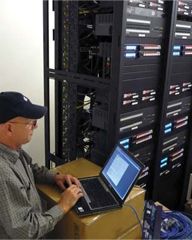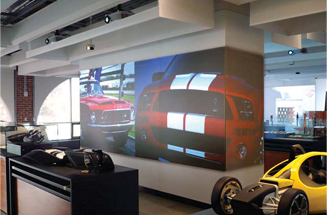A Software Developer Projects Success
SAN FRANCISCO, CA—A team of designers and integrators recently had the daunting task of making a software developer’s vision of a gallery into an optical smorgasbord of projects that utilized their software. This gallery would focus on the capabilities of the client’s software products as a critical component of the design industry and would be a key part of the $10 million, 16,500-square-foot Executive Briefing Center. In addition to the gallery, the space features several conference rooms, a divisible training room, a theater, and a software development lab.
Eighteen TV One C2-7100 video processors helped to create ten four-sided projection “wraps” at a San Francisco Executive Briefing Center. to the historic structure.
Videos of designs that used the client’s software would be projected on floor-to-ceiling four-sided projection “wraps” (eight wraps in the main space and two in the lobby). D’Angelo advised the client to change the viewing area on the wraps to begin at knee level for better viewing and to better accommodate the aspect radio of the videos.
The goal of the display wraps was to feature customers’ creations, edu- S3N8 ASNPASPSHHOOTTSS Eighteen TV One C2-7100 video processors helped to create ten four-sided projection “wraps” at a San Francisco Executive Briefing Center. ( continued on page 40 ) THE PERFECT BLEND A Software Developer Projects Success cate visitors on the design process, and show the endless possibilities of the client’s software. In addition, video from the main theater could be sent to any wrap and audio could be sent to the entire floor or zone.
Nick Taylor, senior project manager from Integrated Communication Systems (ICS) was awarded the AV installation. ICS is a multi-disciplined communications contractor/integrator for audiovisual systems, based in the Northern California Bay area for more than 25 years.
Forty-nine NEC NP3150 LCD 1024x768 5K Lumen projectors were used. They were chosen for their optics and their significant level of keystone correction. Ideally large amounts of keystone correction are to be avoided, but it was required due to a camouflage mounting scheme within the unique ceiling that dictated a high downward projection angel. Keystone correction for the NEC NP3150 can be performed by remote control, which corrects vertical or horizontal distortions up to a maximum +/-40 degrees horizontally and a maximum +/-30 degrees vertically.
Between client-scheduled visits to the gallery, the projectors are shut down several times per day to help ease their workload and extend lamp life. These programmed shut-downs are accomplished automatically or can be manually overridden via input on a touch panel at the main equipment rack.

Bill Gordon, senior systems engineer, Integrated Communication Systems. all of the edges, multiple images can be aligned vertically, horizontally, or both to create unusual displays. Since it is dual-channel, only one unit is required to blend two edges. Using multiple C2 units, a large number of images can be blended.
Edge blending is not limited to high-resolution RGB computer images, but can be applied to any input. Gamma correction is employed to compensate for many of the problems faced when blending between projectors. Special preparation of the video in advance is not necessary, since all processing is done within the unit.
Eighteen TV One C2-7100 video processors were chosen to complete the project. The C2-7100 aided in repositioning the projected images to compensate for slight variations in the mounting of the projectors. Nick Taylor of ICS commented, “The TV One C2-7100 product offered us all the right features, capabilities, and proper fit into a tight project budget.”
To meet the significant video and audio routing requirement for this project, a master router was used to allow auxiliary feeds, such as those from the main meeting theater to be sent to any wrap. Audio can be sent to the entire floor or to a particular audio zone. All told, there are a total of 115 multi-zoned speakers in the gallery space.










